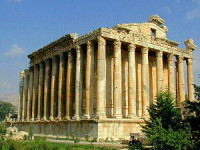|

During Classical Antiquity, the city's temple to Baʿal Haddu was conflated first with the worship of the Greek sun god Helios[17] and then with the Greek and Roman sky god under the name "Heliopolitan Zeus" or "Jupiter". The present Temple of Jupiter presumably replaced an earlier one using the same foundation;[n 4] it was constructed during the mid-1st century and probably completed around ad 60.[n 5][55] His idol was a beardless golden god in the pose of a charioteer, with a whipraised in his right hand and a thunderbolt and stalks of grain in his left;[58] its image appeared on local coinage and it was borne through the streets during several festivals throughout the year.[56] Macrobius compared the rituals to those for Diva Fortuna at Antium and says the bearers were the principal citizens of the town, who prepared for their role with abstinence, chastity, and shaved heads.[56] In bronze statuary attested from Byblos in Phoenicia and Tortosa in Spain, he was encased in a pillarlike term and surrounded (like the Greco-Persian Mithras) by busts representing the sun, moon, and five known planets.[59] In these statues, the bust of Mercury is made particularly prominent; a marble stela at Massilia in Transalpine Gaul shows a similar arrangement but enlarges Mercury into a full figure.[59] Local cults also revered the Baetylia, black conical stones considered sacred to Baʿal.[51] One of these was taken to Rome by the emperor Elagabalus, a former priest "of the sun" at nearby Emesa,[60] who erected a temple for it on the Palatine Hill.[51] Heliopolis was a noted oracle and pilgrimage site, whence the cult spread far afield, with inscriptions to the Heliopolitan god discovered in Athens, Rome, Pannonia, Venetia, Gaul, and near the Wall in Britain.[57] The Roman temple complex grew up from the early part of the reign of Augustus in the late 1st century bc until the rise of Christianity in the 4th century. (The 6th-century chronicles of John Malalas of Antioch, which claimed Baalbek as a "wonder of the world",[60] credited most of the complex to the 2nd-century Antoninus Pius, but it is uncertain how reliable his account is on the point.)[8] By that time, the complex housed three temples on Tell Baalbek: one to Jupiter Heliopolitanus (Baʿal), one to Venus Heliopolitana (Ashtart), and a third to Bacchus. On a nearby hill, a fourth temple was dedicated to the third figure of the Heliopolitan Triad, Mercury (Adon or Seimios[61]). Ultimately, the site vied with Praeneste in Italy as the two largest sanctuaries in the Western world.






 Please share your ideas with us.
Please share your ideas with us.